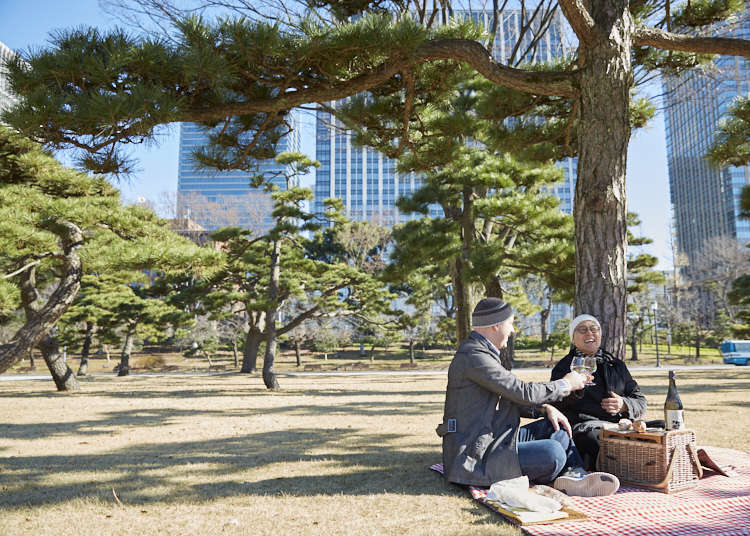
This half-day Tokyo itinerary around Marunouchi was planned by Mr. Tetsu Morita, who was actively involved in the production of the Michelin Green Guide Japan. With his familiarity of Westerners’ tastes, he provides a view of Japan that even Japanese people themselves might not be aware of. Let's dive right in!
- Table of Contents
-
- Jan Joosten and William Adams: Two foreigners who brought the Liefde to Japan
- The Mitsubishi Ichigokan Museum: Formerly the Very First Office Building in Marunouchi by Josiah Conder
- A Refined Picnic under Pine Tree Thicket Imperial Palace
- Idemitsu Museum of Arts: enjoy ancient oriental culture alongside a sweeping view atop the Imperial Palace
- Café 1894: A revival of classic architecture within a Meiji-era bank building
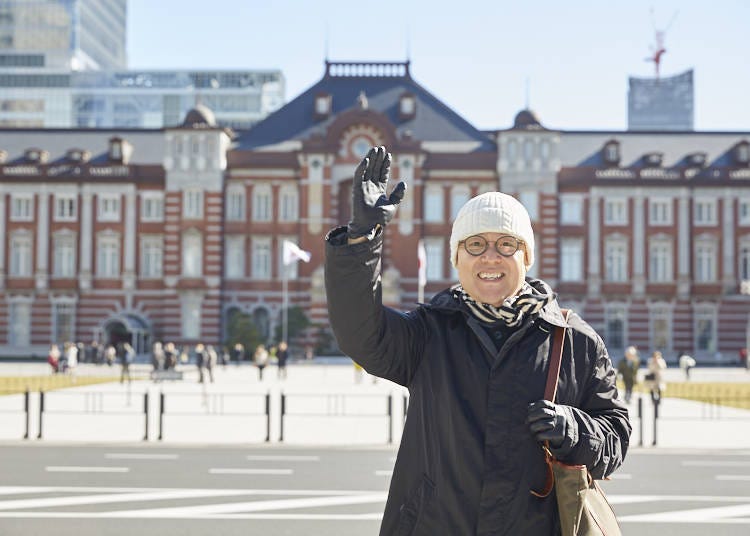
With the company of Live Japan editor and New Yorker Timothy, their journey starts with a morning rendezvous at the Gyōkō-dori Avenue, just beyond the Marunouchi Central Plaza.

Morita: “Good morning, Timothy! Where we are now, Marunouchi, is right by the Edo castle, where the mansions of the Daimyō and his vassals, the daimyō yashiki, are located. Presently it’s also the Imperial Palace where the Emperor lives.”
Timothy: “Wow, it is pretty close by. The place also gives off the feeling of a central business district.”
Morita: “Well, after the Meiji Restoration the second president of the Mitsubishi group, also a relative of its founder, Iwasaki Yanosuke bought the whole piece of land from the Meiji government and developed it as a business area alongside its real estate sector. For today, we’ll follow the trail of history of the Marunouchi/Yaesu area as well as the surrounding areas.”
Jan Joosten and William Adams: Two foreigners who brought the Liefde to Japan
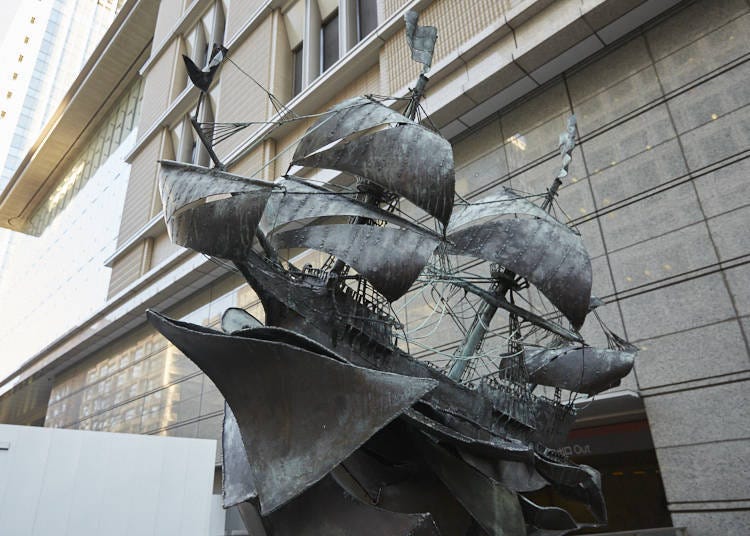
Morita: “Do you know the etymology behind the name ‘Yaesu’? Back in the Edo period, a Dutch man by the name of Jan Joosten came to serve the Daimyo as a samurai and lived in the mansions around here. His Japanese name was ‘Yayōsu’, which they took reference from and named the area ‘Yaesu’.”
Timothy: “Wait, why was there a Dutch Samurai in the Edo period in the first place? Not to mention he was a lord?”
Morita: “In April of the year 1600, Jan Joosten and William Adams, a Dutch and Englishman respectively, were aboard a boat that drifted ashore at Usuki, Oita Prefecture in Kyushu. After which, Jan Joosten often advised the Tokugawa clan on foreign affairs. Shortly after the Tokugawa clan rose to become the Shogunate, and Jan Joosten was allowed residency at one of the mansions.”
Timothy: “There was this old American drama called ‘SHOGUN’ that was quite the topic back then. Was this the model they used for the story of a Caucasian samurai?”
Morita: “Ah, that’s likely William Adams. The man was given ownership over the Miura peninsula, and was subsequently given the name ‘Miura Anjin’. A model of the ship he was aboard, the Liefde, lies in a corner of the Marunouchi Building.”
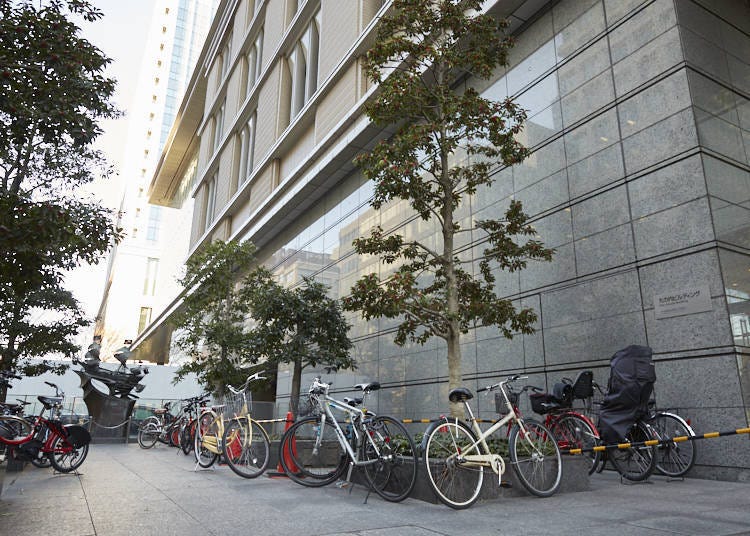
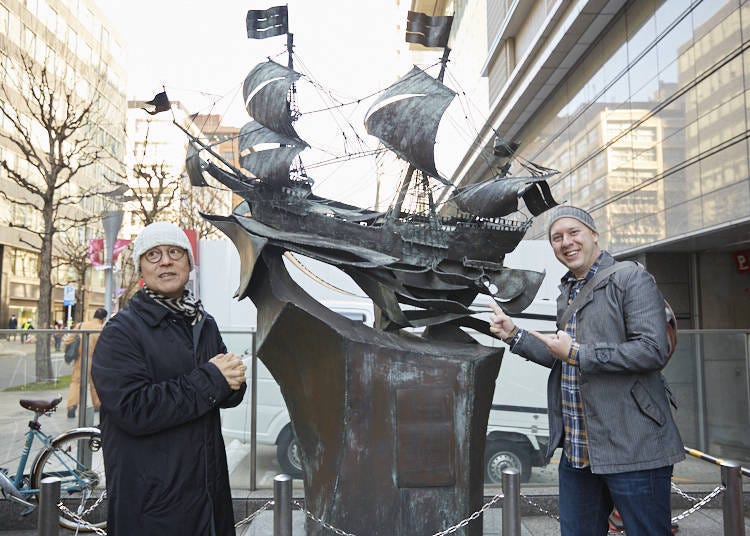
Timothy: “You mean this? It’s just standing quietly in this little corner of the bicycle area, huh.”
Morita: “This model is actually a gift from Holland. The fact that there were European samurai in the early part of 1600 when the Edo bakufu was formed is amazing enough, and they even served the Tokugawa shogunate! Incidentally, there’s also a statue of Jan Joostan in the underground shopping center too.”
-

-
Address
2-4-1, Marunouchi, Chiyoda-ku, Tokyo, 100-6390
View Map -
Nearest Station
Tokyo Station (Tokaido Shinkansen Line / Hokkaido Shinkansen Line / Tohoku Shinkansen Line / Akita Shinkansen Line / Yamagata Shinkansen Line / Joetsu Shinkansen Line / Hokuriku Shinkansen Line / JR Tokaido Main Line / JR Yokosuka Line / JR Sobu Main Line / JR Sobu Main Line (Rapid) / JR Keihin-Tohoku Line / JR Yamanote Line / JR Chuo Main Line / JR Keiyo Line / JR Ueno Tokyo Line / Tokyo Metro Marunouchi Line)
1 minute on foot
- Phone Number 03-5218-5100
-
Address
2-4-1, Marunouchi, Chiyoda-ku, Tokyo, 100-6390


Location: Yaesu Underground Mall
Tokyo-to, Chuo-ku, Yaesu 2-1 Basement 1/2
The Mitsubishi Ichigokan Museum: Formerly the Very First Office Building in Marunouchi by Josiah Conder
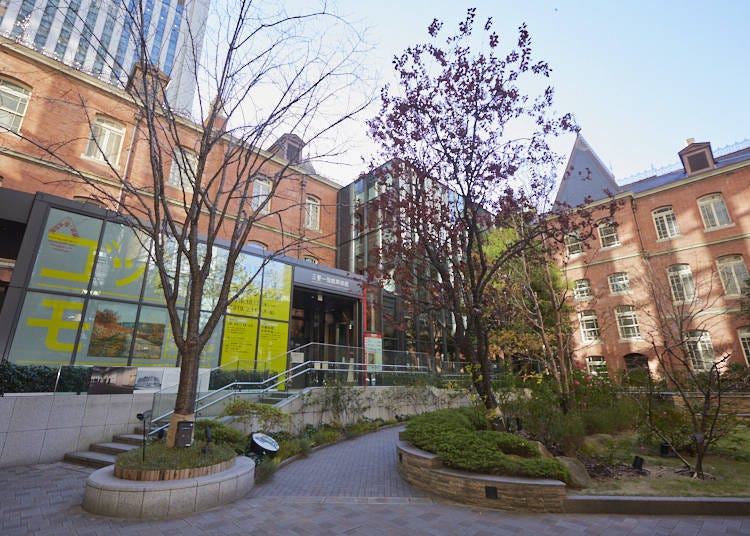
After their discussions about the blue-eyed samurai from the Netherlands, Timothy and Morita find themselves in the Mitsubishi Ichigokan Museum a short distance away from the Marunouchi Building.
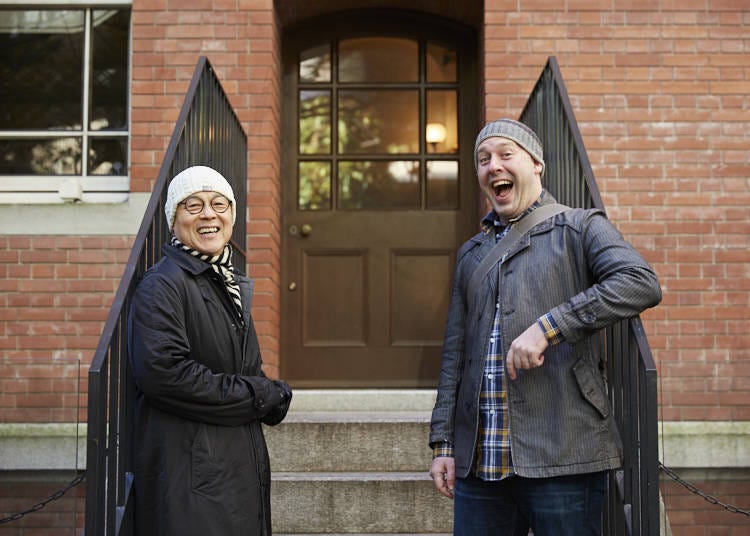
Morita: “Timothy, have you been to this museum? This place is one of my favorite spots, although it only opened fairly recently in 2010. Actually, this building used to be the very first office building in Marunouchi and was designed by British architect Josiah Conder in 1894, refurbished with attention all the way to the materials used and the construction method. 2,300,000 bricks were used in the reconstruction, but they were apparently contracted to be as close to the material and manufacturing method as possible.”

Morita: “The Mitsubishi Ichigokan Museum also offers a very worthwhile year-long pass where you can visit the museum anytime you want at 4000 yen per pass, and it’s discounted to a total of 7500 yen when you buy 2 passes. Not only do you get a lot of exclusive membership benefits, it’s the perfect place to visit while you’re out on a walk.”
Timothy: “I really want to introduce this place to other expats living in Japan.”
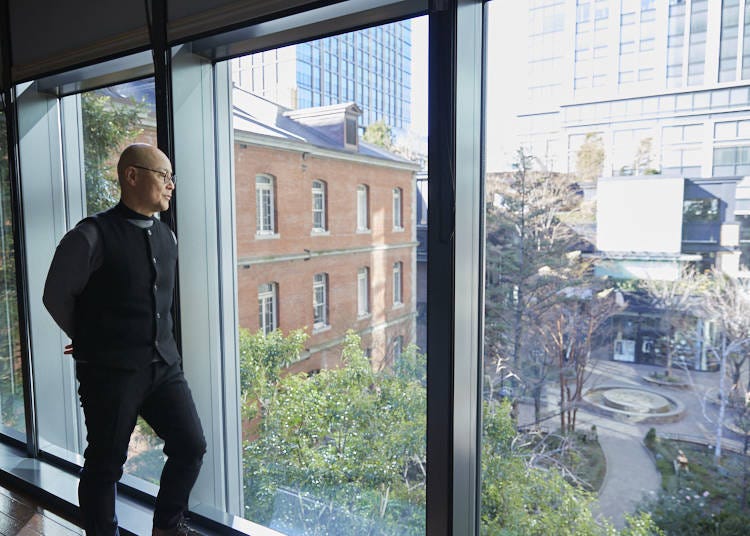
Morita: “Not just the exhibitions here, but even the rest area in the brick square is nice to look at. Conder’s love for roses is well-known, so in honor of that love more than 40 varieties of roses are being grown here. Usually at least some of the roses would be in bloom.”
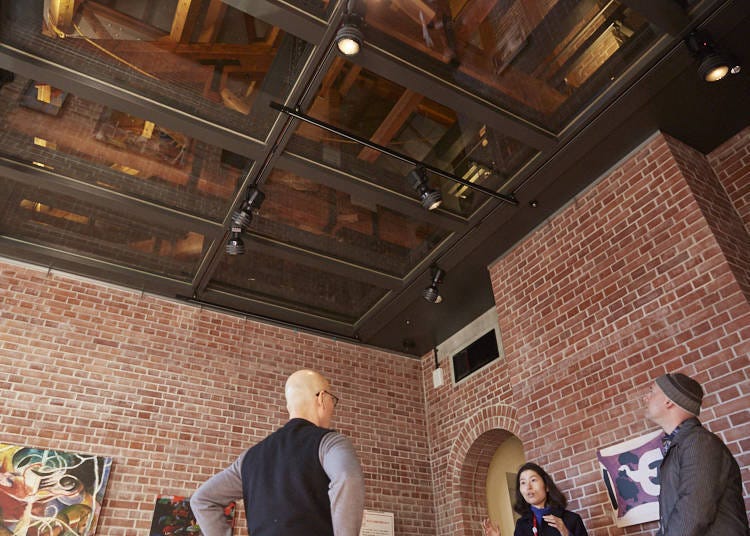
Morita: “While the museum is a brick building, the roof is made of wood, just like how it was in the 1890s. Conder made this building by introducing the strengths of Japanese architecture to Western architecture. In this room, you can see said wooden structures of the time behind fireproof glass."
Timothy: “A literal blend of the East and West, huh.”

Morita: “Conder apparently studied the Japanese climate and frequent earthquakes fervently. As it happens, the Mino-Owari Earthquake happened right before the planning for the building, and so he witnessed firsthand the extent of the damage. After the official reports, he used no less than 9000 pine tree pickets to secure a strong foundation for the building before construction.”
Timothy: “So he judged that for a country like Japan which frequently experiences earthquakes, that amount of preparation was necessary.”
Morita: “Actually, the pine tree pickets used that time were discovered when they were reconstructing the new building. One such picket from the old Marunouchi Building is actually on display at the current Marunouchi Building.”
Leaving the Mitsubishi Ichigokan Museum, Morita and Timothy arrive in the Marunouchi Building, where the pine picket they sought lay at the first floor’s office entrance hall. Inside, the sheer size of a single pine picket oppressively stands out.
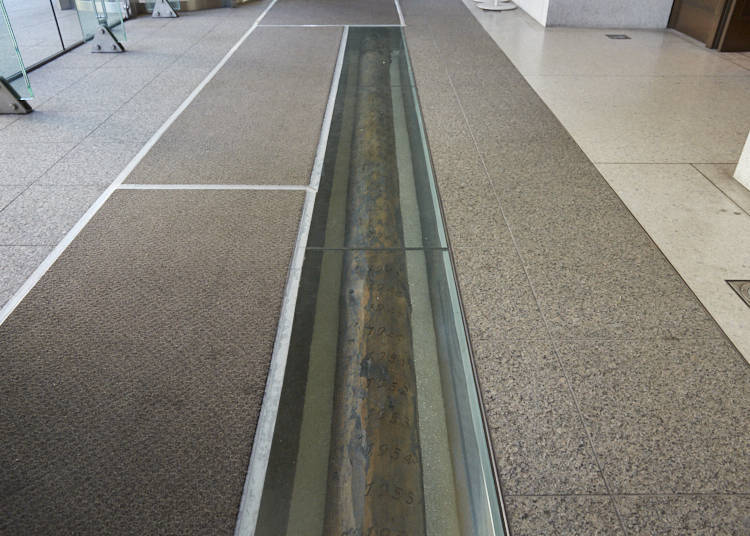
Timothy: “Wow, it’s a lot bigger than I thought! It’s at least 15 meters long.”
Morita: “Just sticking one of these into the ground requires a lot of effort. However, to build a strong and safe building on brittle ground, Condor judged that he needed 9000 of them, and proceeded with large-scale construction. It was one of those times where you can really feel the pride of a pro at work.”

Timothy: “I wonder if it was because of the man’s success with the museum that Japan ended up with so many Western-style buildings built.”
Morita: “Just so. Conder was also the teacher of Kingo Tatsuno, the man who constructed Tokyo Station. If Conder didn’t exist, the surrounding area would look very different from now.”
-

-
Address
2-6-2, Marunouchi, Chiyoda-ku, Tokyo, 100-0005
View Map -
Nearest Station
Tokyo Station (Tokaido Shinkansen Line / Hokkaido Shinkansen Line / Tohoku Shinkansen Line / Akita Shinkansen Line / Yamagata Shinkansen Line / Joetsu Shinkansen Line / Hokuriku Shinkansen Line / JR Tokaido Main Line / JR Yokosuka Line / JR Sobu Main Line / JR Sobu Main Line (Rapid) / JR Keihin-Tohoku Line / JR Yamanote Line / JR Chuo Main Line / JR Keiyo Line / JR Ueno Tokyo Line / Tokyo Metro Marunouchi Line)
5 minutes on foot
- Phone Number 03-5777-8600
-
Address
2-6-2, Marunouchi, Chiyoda-ku, Tokyo, 100-0005
-

-
Address
1-5-1, Marunouchi, Chiyoda-ku, Tokyo, 100-6590
View Map -
Nearest Station
Tokyo Station (Tokaido Shinkansen Line / Hokkaido Shinkansen Line / Tohoku Shinkansen Line / Akita Shinkansen Line / Yamagata Shinkansen Line / Joetsu Shinkansen Line / Hokuriku Shinkansen Line / JR Tokaido Main Line / JR Yokosuka Line / JR Sobu Main Line / JR Sobu Main Line (Rapid) / JR Keihin-Tohoku Line / JR Yamanote Line / JR Chuo Main Line / JR Keiyo Line / JR Ueno Tokyo Line / Tokyo Metro Marunouchi Line)
1 minute on foot
- Phone Number 03-5218-5100
-
Address
1-5-1, Marunouchi, Chiyoda-ku, Tokyo, 100-6590
A Refined Picnic under Pine Tree Thicket Imperial Palace
After having their fill of the museum and gaining insight on the professionalism of Josiah Conder, the duo’s stomachs are feeling rather empty.
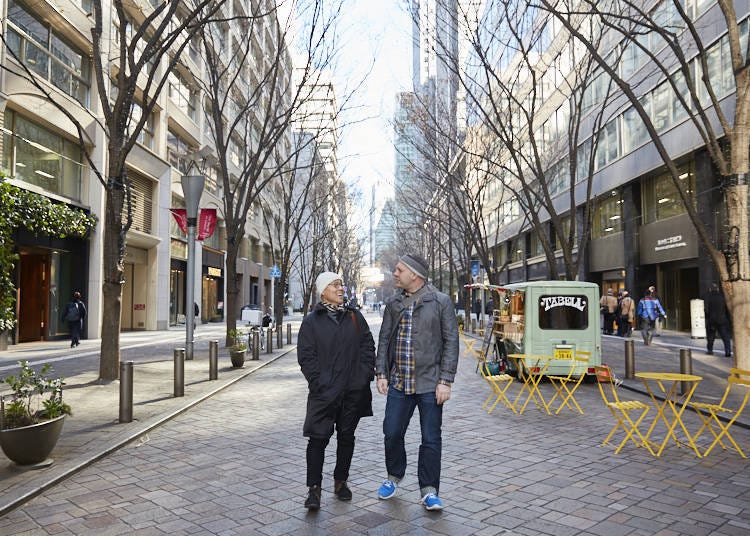
Morita: “What do you think about a picnic at the Imperial Palace Outer Gardens? There’s a bunch of shops here that sell great takeaway food, so we can grab a few as we make our way there.”
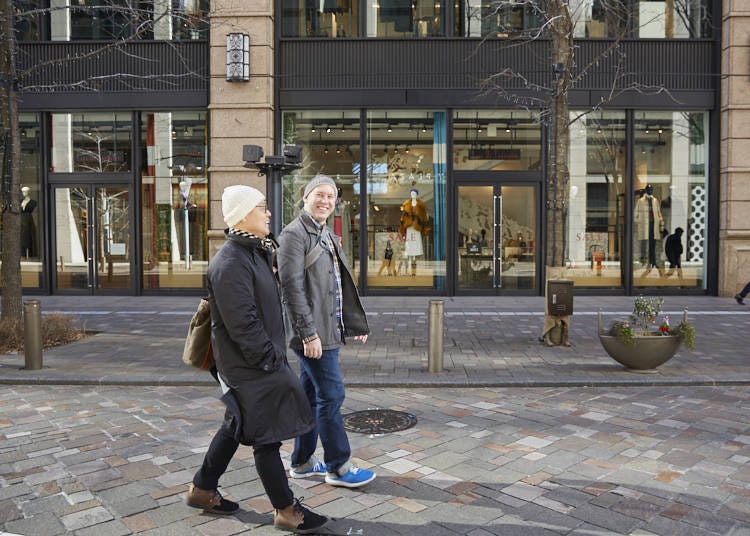
As they strolled down the Marunouchi Nakadori Avenue, the duo bought some sandwiches, croissants and drinks.
Finally, they arrive at their goal: The Imperial Palace Outer Gardens. After laying out the sheet graciously provided by Morita, they begin their dandy picnic together.
Timothy: “We can get to the lawn from here?”
Morita: “Yes, but only in the day. These kinds of pine trees growing about must be a rare sight for folks from abroad, huh.”
Timothy: “When I think of pine trees I kind of get the image of bonsai, so it’s pretty cool that these kinds of gigantic trees are part of the same family too. It really feels like I’m standing in a giant bonsai pot! Doesn’t get more Japanese than this.”
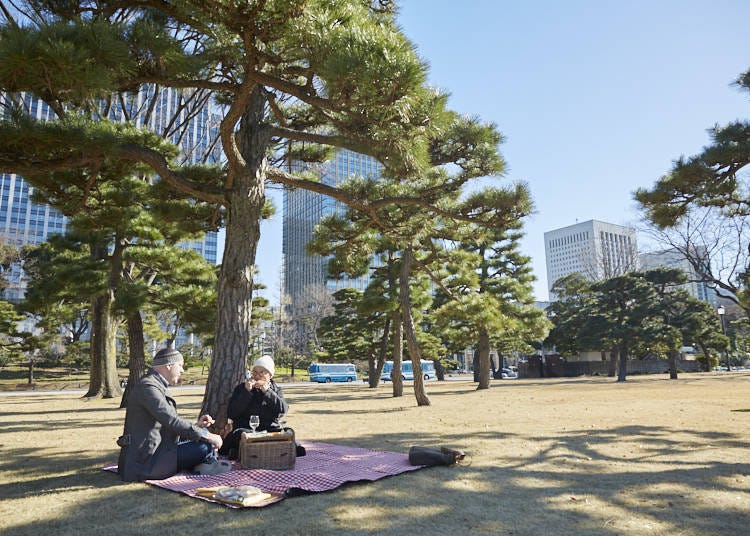
Timothy: “I thought that the Japanese Emperor’s residences have been here since the start, but this actually used to be the Tokugawa Shogunate’s castle, huh.”
Morita: “Exactly. The Emperor's residence used to be in Kyoto. It was moved to Tokyo in 1868 during the start of the Meiji Restoration, and Edo Castle was repurposed to the Emperor’s castle in 1869. In other words, the start of the Meiji era was when Emperor Meiji himself moved to Edo. It was only officially called the Emperor’s residences in 1948. The Tokugawa Shogunate first claimed the castle in 1600, so it actually belonged to the Tokugawa clan for 268 years. By the by, the emperors lived in Kyoto for 794 years.”
Timothy: “Jeez, that kind of time scale is really something. A thousand years! Just thinking that the Tokugawa Shogunate and the Emperor themselves saw these same stone walls and canals is impressive.”

Idemitsu Museum of Arts: enjoy ancient oriental culture alongside a sweeping view atop the Imperial Palace
After their little picnic at the gardens, the pair proceeded to the Idemitsu Museum of Arts on the 9th floor of the Imperial Theatre.
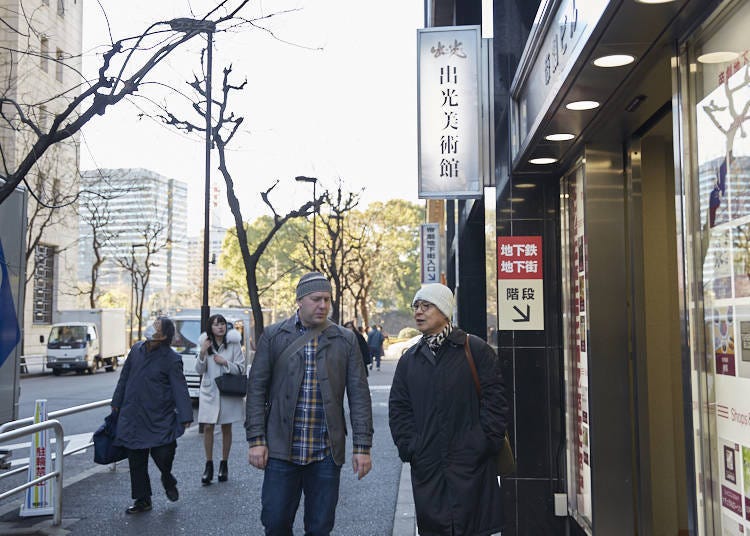
There, they immersed themselves in an exhibition of oriental artworks and proceeded to take a rest at the lobby as they enjoyed a splendid view of the Imperial Palace Outer Gardens along with a cup of tea.
Morita: “Oriental artworks aren’t too bad, either right? Not to mention, I really like the lobby here.”

Timothy: “The view from the lobby here is amazing. The view of the stone walls and canal really serves as a reminder that samurai actually lived here.”
Morita: “Right here is the middle of Tokyo, but since excavation is not allowed beneath the imperial lodgings, subway lines don’t run underneath here.”
Timothy: “I see. So that’s why the Yurakucho Line runs through in between the castle and Marunouchi and goes around from Akasaka and Ichigaya to Kagurazaka on the opposite side along the moat.”
Morita: “Yup. You’re really familiar with the subway here, huh! Rather than a New Yorker you sound more like a true-blue Tokyoite (chuckles).”
Café 1894: A revival of classic architecture within a Meiji-era bank building
The last stop for our duo is tucked in the corner of a nearby building. The pair takes a moment of reprieve at “Café 1894”, where they look back at their day’s adventures.
The establishment is a museum café-bar hybrid, which used to be a bank in the Meiji period. Open from 11am to 11pm, it serves all manner of lunches, tea, and dinner.
Timothy: “It really looks like the inside of a bank.”
Morita: “The windows and lighting were replicated faithfully, which is why the window has an arch that resembles the bank’s counter. The names of sponsors are also engraved on the upper part of the pillars, and one particular pillar that was left from the previous building was renovated by 3 craftsmen over a half-year period.”
Timothy: “Even the tables and window panes accurately reflect the atmosphere.”
Morita: “The furniture was also carefully chosen to replicate the atmosphere of the period accurately. The glass too, is the same as that of the Shin-Marunouchi Building of that time. The material is a lot different from modern glass which have no distortions in them, which gives the place a truly unique air. Doesn’t it feel great, enjoying a meal in a place like this an enjoyable experience at a museum?”
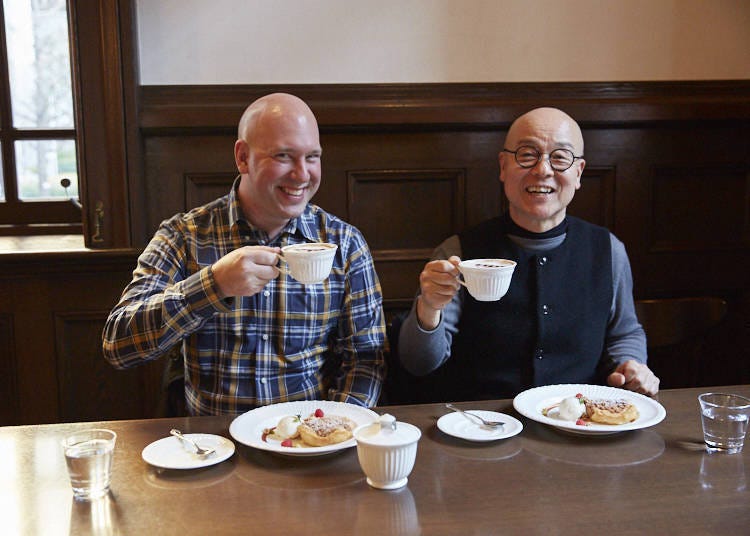
Timothy and Morita bought a slice of “Café 1894 Homemade Classic Apple Pie” (840-yen tax inclusive). The sweet mellow apple filling compliments the crunchiness of the crumble, emphasizing the firm dough of the pie.

Morita: “There’s a French dish called “tartetatin” that’s also apple-based, but apple pie is like the American version of it.”
Timothy: “Nothing beats the sourness of apple and the sweetness of vanilla ice cream after a long day of walking.”

With an 8-meter-tall ceiling, the café doesn’t lose out in spaciousness.
Customers will eventually find it hard to part with the cozy relaxed atmosphere.
Morita: “A long time ago, the dandy gentlemen and ladies working at Marunouchi would lounge about here as they reminisced about their past. Coming here in person, you can understand why they did that.”
Timothy: “The area around here really has a nice atmosphere. Towering skyscrapers side by side surrounding a park like a little garden along with retro buildings, this bold blend of features really screams Tokyo more than anything.”

Morita: “Past and present, east and west. This mix of era and culture can be said to be Tokyo’s charm.”
Timothy: “I think so too. And the fact that in the middle of this supposed storm of culture Japan retains a sense of oneness feels kind of pleasant to folks from the West.”
Morita: “One of the reasons for that singular feeling is probably thanks to Mr. Iwasaki from Mitsubishi buying over the entire plot of land from the Meiji government. Although it’s close by the Imperial Residences, the whole of Marunouchi was designed by the Mitsubishi group.”
Timothy: “Showing me around Marunouchi today really changed my impressions of this place. I really want to try bringing my friends from New York around too.”
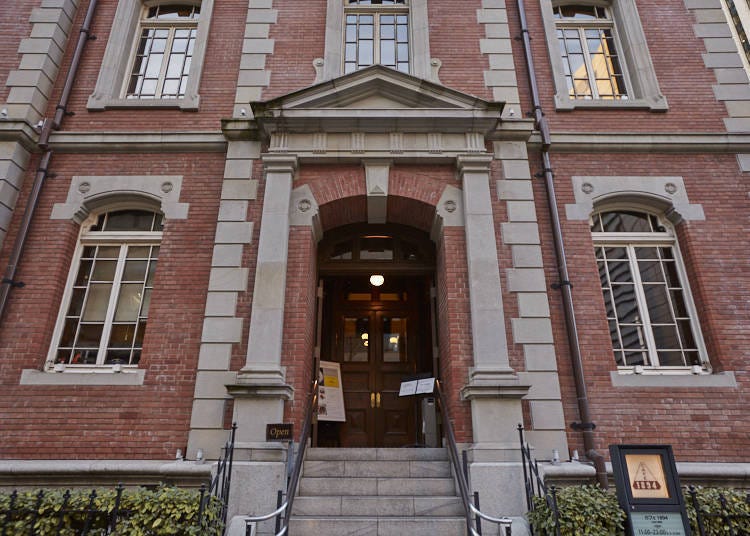
Café 1894
Tokyo-to Chiyoda-ku Marunouchi 2-6-2 Mitsubishi Ichigokan Museum 1F
Contact No.: 03-3212-7156
Hours: 11:00 - 23:00 (Last Order: 22:00)
Open Daily
Jan Joostan, the samurai who was the namesake of Yaesu after drifting ashore and joining the Edo Bakufu at the end of the Sengoku period, as well as Josiah Conder, the samurai who introduced British architecture to Japan and the beginning of the Meiji era. These two individuals were vital to the development of Japan as a nation and this trail traced their steps, unveiling the history of Japanese statesmen and the process of Japan’s development.
- Area
- Category
*Prices and options mentioned are subject to change.
*Unless stated otherwise, all prices include tax.
Popular Tours & Activitiess
Recommended places for you
-

LaLaport TOKYO-BAY North Building Now Open: Shop, Dine & Enjoy Events at LaLa arena, Just 2 Stops from Disney
by: Wemmy Chau
-
Ad

Walk in the Footsteps of Believers: A 4-Day Pilgrimage Across Goto Islands, Nagasaki Prefecture
by: Yohei Kato
-

See Asakusa and Tokyo Skytree® in a New Light at the "Také Akari" Festival (Winter 2025-2026)
by: Guest Contributor
-

2025 Autumn Colors Report: Kurobe Gorge Nearing Peak
by: Timothy Sullivan
-

Enjoy Japan's Gorgeous Winter Lights! Ride the Romancecar to Shonan no Hoseki Illumination
by: Guest Contributor
-

2025 Japan Autumn Color Report: Tokyo's Ginkgo Trees Starting to Glow
by: Timothy Sullivan
Inspiration for Accommodations
-

Enjoy Mt. Fuji from the Comfort of Your Room! Recommended Ryokan with Mt. Fuji View
-

Stay Near the Cherry Blossoms! Hotels for Cherry Blossom Viewing in Tokyo
-

Family-Friendly Hotels with Free Shuttle to Disneyland: Convenient Access for a Magical Stay
-

Top Ranked Hakone Hotels with Mt. Fuji View: Enjoy Stunning Scenery from Your Private Space
-

Convenient Tokyo Hotels with Airport Shuttle: Ideal for Families and Heavy Luggage
-

Stunning Tokyo Tower View Hotels: Enjoy Spectacular Scenery from Your Private Space
-

Convenient Asakusa Hotels with Kitchens: Ideal for Extended Family Visits
-

Experience Luxury: Hakone's 10 Best Five-Star Accommodations
-

Enjoy Mt. Fuji Autumn Leaves! Top Hotels Near the Popular Autumn Leaves Corridor
-

Experience Hakone Fall Foliage from Your Room with Stunning Views
-

Spending Wonderful Time Alone in Shibuya - Free Cosmetics and a Hundred-Yen Bus!
-

Avoid Luggage Problems: How to Check Tokyo Metro's Open Coin Lockers Online
-

Perfect for Families on a Budget! Top 5 Places in Shibuya you Can Enjoy For Free
-

Ueno Station Area Guide: Fun Ways to Explore Tokyo's Popular Destination (Area Map & Sightseeing Tips)
-

Exploring Tokyo Station: 11 Must-Visit Spots Around the Heart of Tokyo
-

Shibuya and Harajuku - Past and Present
- #best ramen tokyo
- #what to buy in ameyoko
- #what to bring to japan
- #new years in tokyo
- #best izakaya shinjuku
- #things to do tokyo
- #japanese nail trends
- #what to do in odaiba
- #onsen tattoo friendly tokyo
- #daiso
- #best sushi ginza
- #japanese convenience store snacks
- #best yakiniku shibuya
- #japanese fashion culture
- #best japanese soft drinks




















